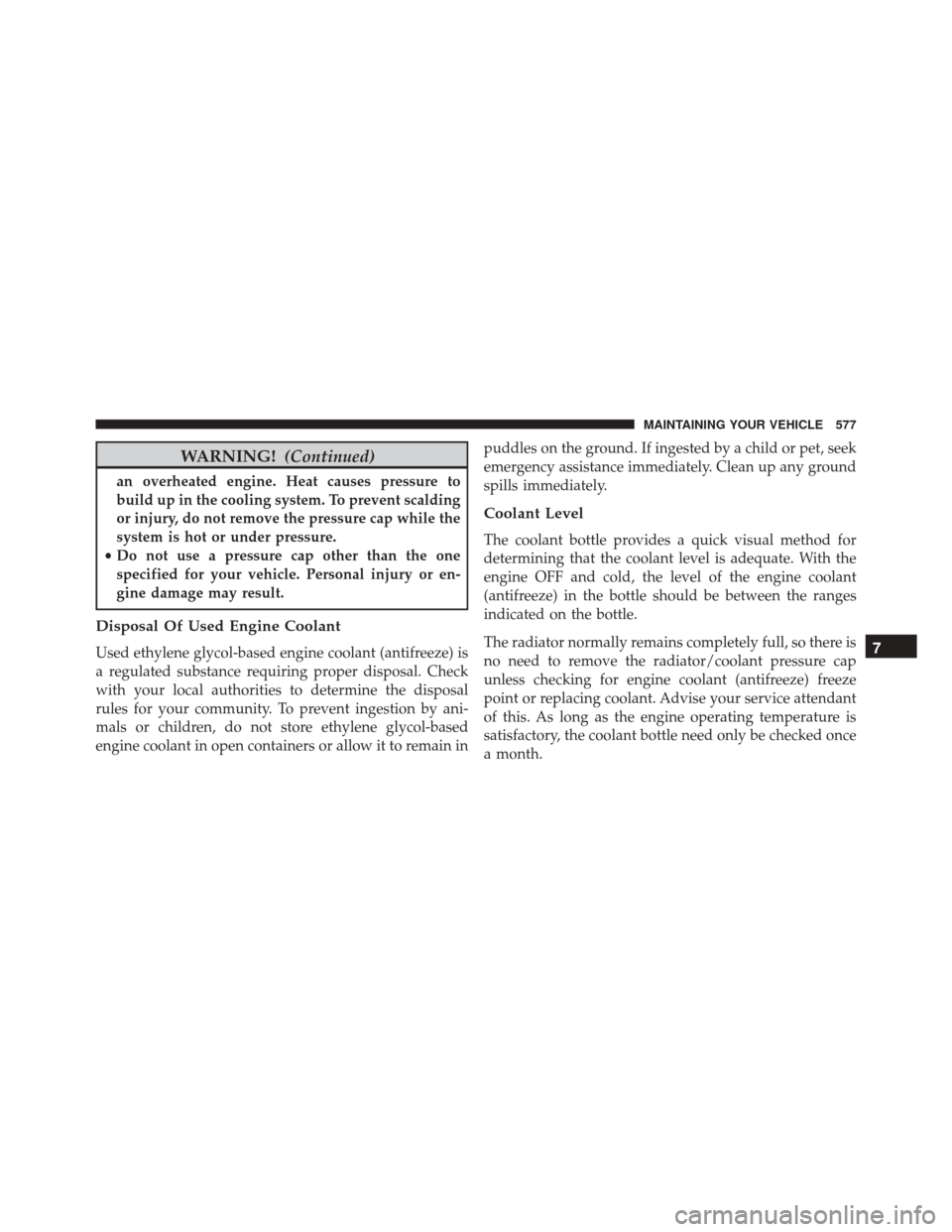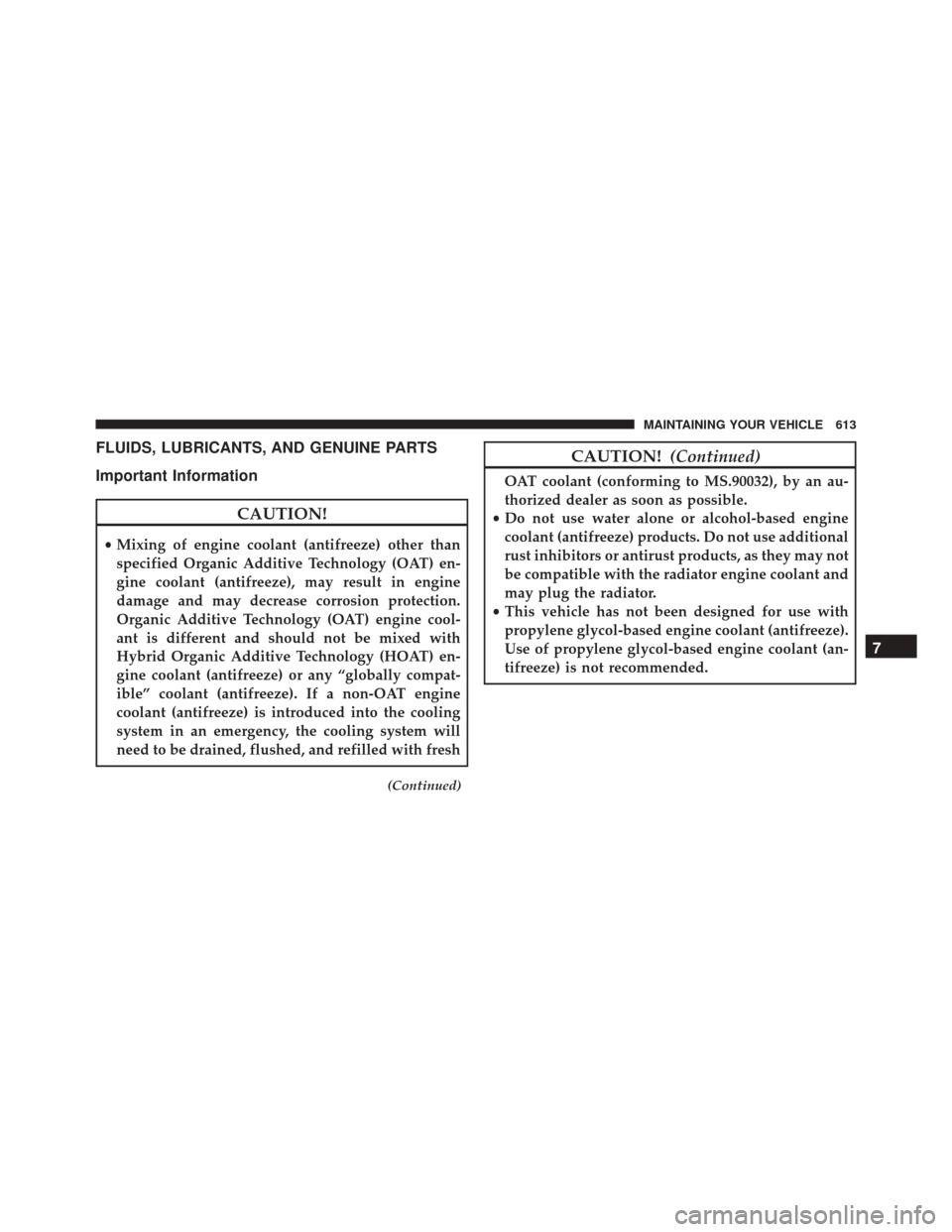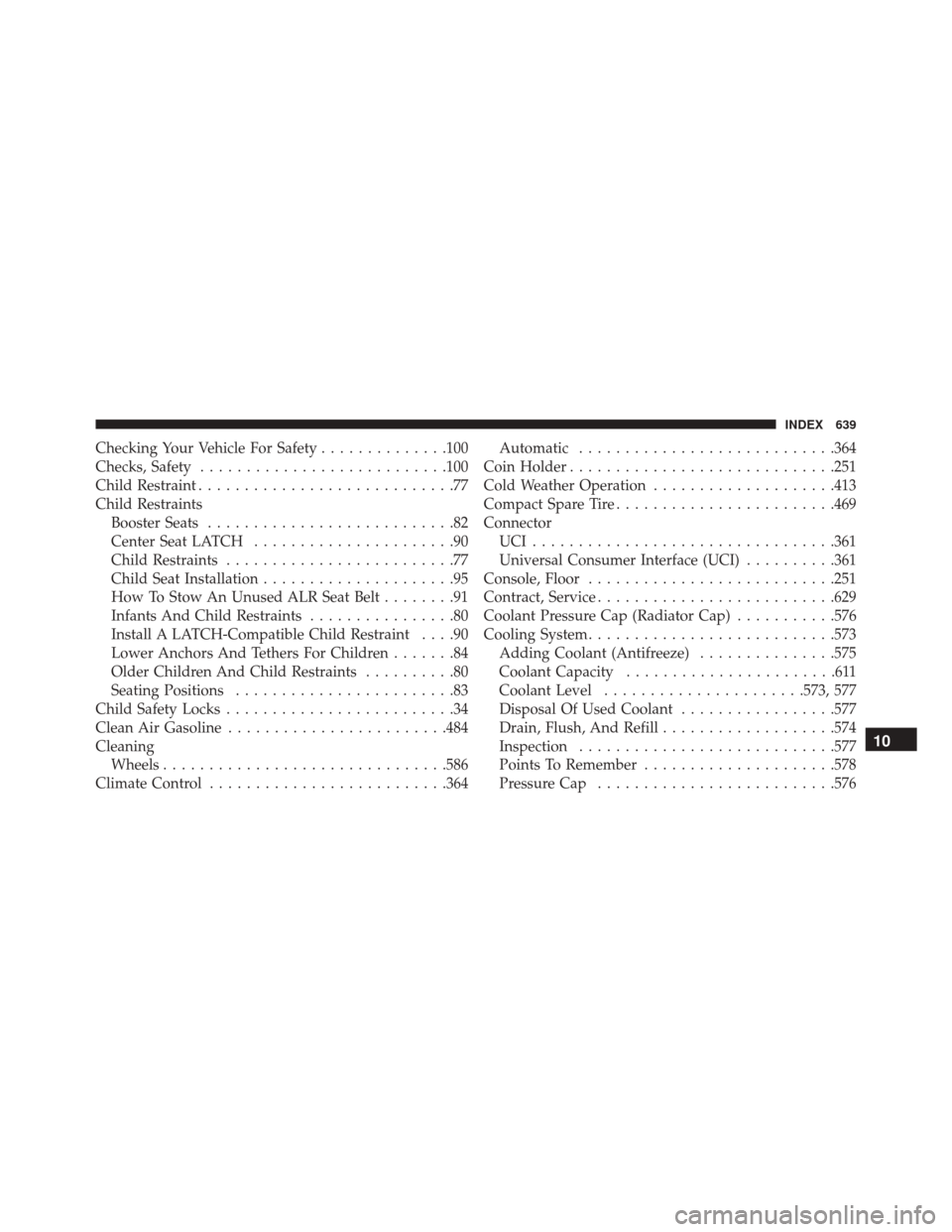Page 579 of 661

WARNING!(Continued)
an overheated engine. Heat causes pressure to
build up in the cooling system. To prevent scalding
or injury, do not remove the pressure cap while the
system is hot or under pressure.
• Do not use a pressure cap other than the one
specified for your vehicle. Personal injury or en-
gine damage may result.
Disposal Of Used Engine Coolant
Used ethylene glycol-based engine coolant (antifreeze) is
a regulated substance requiring proper disposal. Check
with your local authorities to determine the disposal
rules for your community. To prevent ingestion by ani-
mals or children, do not store ethylene glycol-based
engine coolant in open containers or allow it to remain in puddles on the ground. If ingested by a child or pet, seek
emergency assistance immediately. Clean up any ground
spills immediately.
Coolant Level
The coolant bottle provides a quick visual method for
determining that the coolant level is adequate. With the
engine OFF and cold, the level of the engine coolant
(antifreeze) in the bottle should be between the ranges
indicated on the bottle.
The radiator normally remains completely full, so there is
no need to remove the radiator/coolant pressure cap
unless checking for engine coolant (antifreeze) freeze
point or replacing coolant. Advise your service attendant
of this. As long as the engine operating temperature is
satisfactory, the coolant bottle need only be checked once
a month.
7
MAINTAINING YOUR VEHICLE 577
Page 580 of 661

When additional engine coolant (antifreeze) is needed to
maintain the proper level, only OAT coolant that meets
the requirements of FCA Material Standard MS.90032
should be added to the coolant bottle. Do not overfill.
Points To Remember
NOTE:When the vehicle is stopped after a few miles/
kilometers of operation, you may observe vapor coming
from the front of the engine compartment. This is nor-
mally a result of moisture from rain, snow, or high
humidity accumulating on the radiator and being vapor-
ized when the thermostat opens, allowing hot engine
coolant (antifreeze) to enter the radiator.
If an examination of your engine compartment shows no
evidence of radiator or hose leaks, the vehicle may be
safely driven. The vapor will soon dissipate.
• Do not overfill the coolant expansion bottle. •
Check the coolant freeze point in the radiator and in
the coolant expansion bottle. If engine coolant (anti-
freeze) needs to be added, the contents of the coolant
expansion bottle must also be protected against freez-
ing.
• If frequent engine coolant (antifreeze) additions are
required, the cooling system should be pressure tested
for leaks.
• Maintain engine coolant (antifreeze) concentration at a
minimum of 50% OAT coolant (conforming to
MS.90032) and distilled water for proper corrosion
protection of your engine which contains aluminum
components.
• Make sure that the coolant expansion bottle overflow
hoses are not kinked or obstructed.
• Keep the front of the radiator clean. If your vehicle is
equipped with air conditioning, keep the front of the
condenser clean.
578 MAINTAINING YOUR VEHICLE
Page 594 of 661
CAUTION!(Continued)
allow water to get into the power distribution
center and possibly result in an electrical system
failure.
• When replacing a blown fuse, it is important to use
only a fuse having the correct amperage rating. The
(Continued)
CAUTION! (Continued)
use of a fuse with a rating other than indicated may
result in a dangerous electrical system overload. If
a properly rated fuse continues to blow, it indicates
a problem in the circuit that must be corrected.
Cavity Cartridge Fuse Mini-Fuse Description
1 –– Fuse – Spare
2 40 Amp Green –Radiator Fan #1 –
(Non 6.2L Supercharged)
3 50 Amp Red –Electric Power Steering #1 –
If Equipped / Radiator Fan
(6.2L Supercharged) – If Equipped
4 30 Amp Pink – Starter
592 MAINTAINING YOUR VEHICLE
Page 595 of 661
CavityCartridge Fuse Mini-Fuse Description
5 40 Amp Green –Electronic Stability Control
6 30 Amp Pink –Electronic Stability Control
7 20 Amp Blue –Police Ignition Run / ACC #1
8 20 Amp Blue –Police Ignition Run / ACC # 2
9 –20 Amp Yellow All-Wheel Drive Module – If Equipped
10 –10 Amp Red Security – If Equipped / Under hood
Lamp – Police
11 –20 Amp Yellow Horns
12 –10 Amp Red Air Conditioning Clutch
13 –– Fuse – Spare
14 –– Fuse – Spare
15 –20 Amp Yellow Left HID – If Equipped
16 –20 Amp Yellow Right HID – If Equipped
18 50 Amp Red –Radiator Fan #2 –
(Non 6.2L Supercharged)
7
MAINTAINING YOUR VEHICLE 593
Page 596 of 661
CavityCartridge Fuse Mini-Fuse Description
19 50 Amp Red –Electric Power Steering #2 –
If Equipped / Radiator Fan (6.2L Supercharged)
20 30 Amp Pink –Wiper Motor
21 30 Amp Pink
20 Amp Blue – Police –
Headlamp Washers – If Equipped
Police Bat Feed #2
22 40 Amp Green /
20 Amp Blue – Police –
Engine Cooling Pump
(6.2L Supercharged) / Police Bat Feed # 3
23 20 Amp Blue –Police Bat Feed # 1
24 20 Amp Blue –Police Ignition Run/ACC Feed # 3
28 –– Fuse – Spare
29 –15 Amp Blue Transmission Control Module
(Challenger/Charger Police) /
Electronic Shift Module (Challenger)
594 MAINTAINING YOUR VEHICLE
Page 615 of 661

FLUIDS, LUBRICANTS, AND GENUINE PARTS
Important Information
CAUTION!
•Mixing of engine coolant (antifreeze) other than
specified Organic Additive Technology (OAT) en-
gine coolant (antifreeze), may result in engine
damage and may decrease corrosion protection.
Organic Additive Technology (OAT) engine cool-
ant is different and should not be mixed with
Hybrid Organic Additive Technology (HOAT) en-
gine coolant (antifreeze) or any “globally compat-
ible” coolant (antifreeze). If a non-OAT engine
coolant (antifreeze) is introduced into the cooling
system in an emergency, the cooling system will
need to be drained, flushed, and refilled with fresh
(Continued)
CAUTION! (Continued)
OAT coolant (conforming to MS.90032), by an au-
thorized dealer as soon as possible.
• Do not use water alone or alcohol-based engine
coolant (antifreeze) products. Do not use additional
rust inhibitors or antirust products, as they may not
be compatible with the radiator engine coolant and
may plug the radiator.
• This vehicle has not been designed for use with
propylene glycol-based engine coolant (antifreeze).
Use of propylene glycol-based engine coolant (an-
tifreeze) is not recommended.
7
MAINTAINING YOUR VEHICLE 613
Page 640 of 661

Axle Lubrication..................... .613, 616
Battery ............................ .273, 563
Charging System Light ...................273
Keyless Transmitter Replacement (RKE) ........24
Location ............................. .563
Belts, Seat .............................. .101
Body Mechanism Lubrication .................569
B-Pillar Location ......................... .457
Brake Assist System ...................... .440
Brake Control System, Electronic ..............437
Brake Fluid ......................... .613, 616
Brake, Parking .......................... .434
Brakes ................................ .436
Brake System ........................ .436, 579
Fluid Check ....................579, 613, 616
Master Cylinder ....................... .579
Parking ............................. .434
Warning Light ..................... .269, 436Brake/Transmission Interlock
.................417
Break-In Recommendations, New Vehicle .........99
Brightness, Interior Lights ...................163
Bulb Replacement ..................... .606, 608
Bulbs, Light ......................... .103, 606
Camera, Rear ........................... .227
Capacities, Fluid ..........................611
Caps, Filler Oil (Engine) .......................... .561
Radiator (Coolant Pressure) ................576
Carbon Monoxide Warning ...............100, 488
Cargo (Vehicle Loading) ....................495
Car Washes ............................ .584
Certification Label ........................ .495
Chains, Tire ............................ .475
Changing A Flat Tire ...................... .516
Chart, Tire Sizing ........................ .452
Check Engine Light (Malfunction Indicator Light) . .555
638 INDEX
Page 641 of 661

Checking Your Vehicle For Safety..............100
Checks, Safety .......................... .100
Child Restraint ............................77
Child Restraints Booster Seats ...........................82
Center Seat LATCH ......................90
Child Restraints .........................77
Child Seat Installation .....................95
How To Stow An Unused ALR Seat Belt ........91
Infants And Child Restraints ................80
Install A LATCH-Compatible Child Restraint ....90
Lower Anchors And Tethers For Children .......84
Older Children And Child Restraints ..........80
Seating Positions ........................83
Child Safety Locks .........................34
Clean Air Gasoline ....................... .484
Cleaning Wheels .............................. .586
Climate Control ......................... .364Automatic
........................... .364
Coin Holder ............................ .251
Cold Weather Operation ....................413
Compact Spare Tire ....................... .469
Connector UCI................................ .361
Universal Consumer Interface (UCI) ..........361
Console, Floor .......................... .251
Contract, Service ......................... .629
Coolant Pressure Cap (Radiator Cap) ...........576
Cooling System .......................... .573
Adding Coolant (Antifreeze) ...............575
Coolant Capacity .......................611
Coolant Level ..................... .573, 577
Disposal Of Used Coolant .................577
Drain, Flush, And Refill ...................574
Inspection ........................... .577
Points To Remember .....................578
Pressure Cap ......................... .576
10
INDEX 639